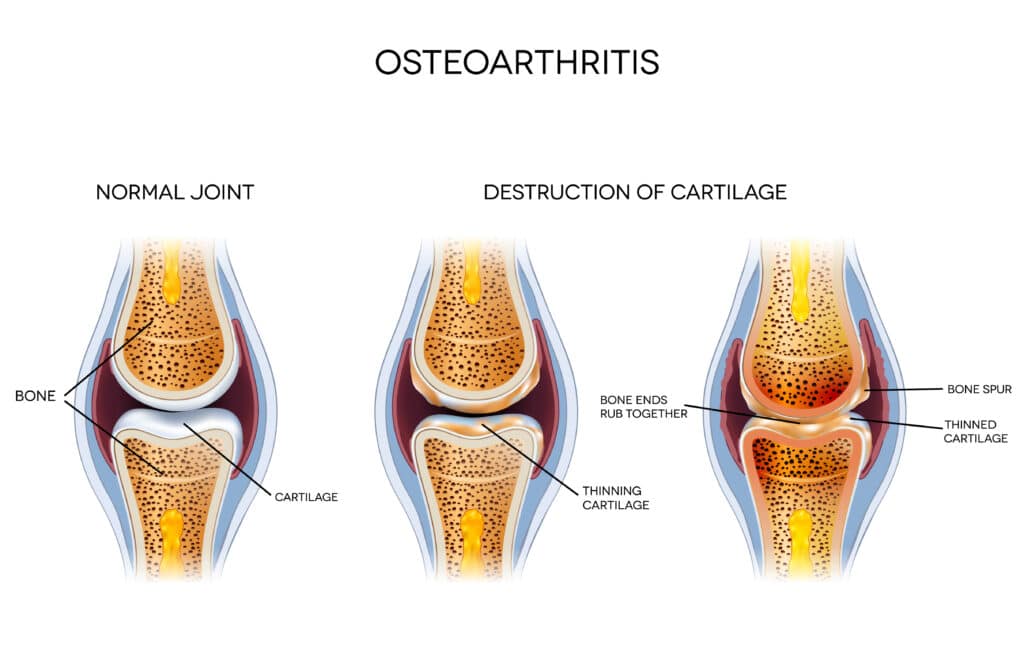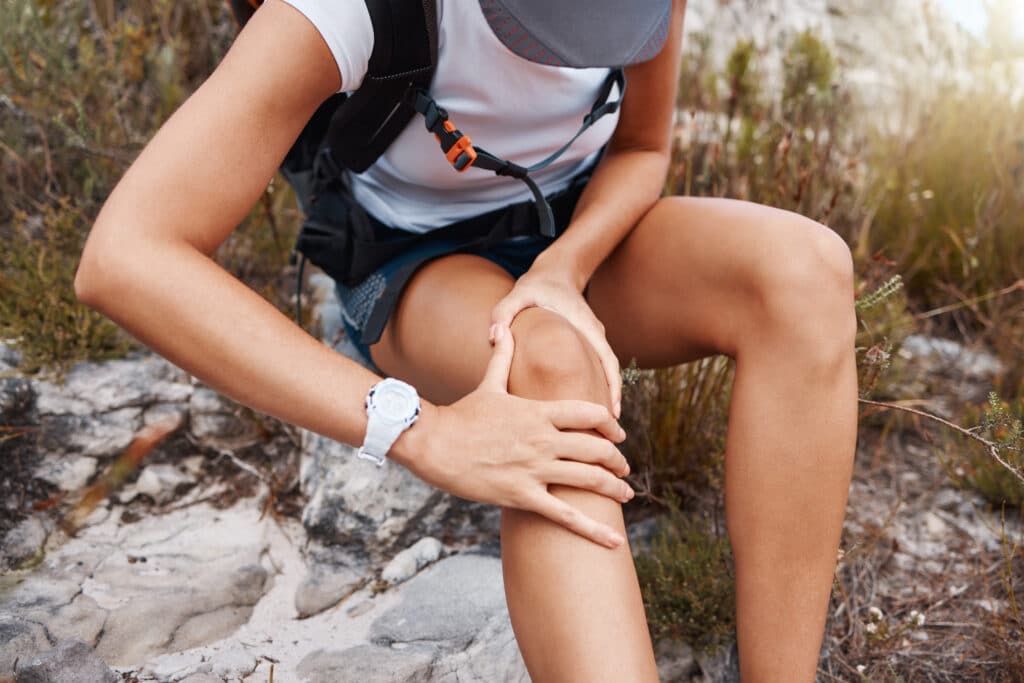New Treatments for Osteoarthritis of the Knee
As medicine advances, more new treatments for osteoarthritis of the knee become available each day. While some of these treatments are still in the research and development phases, there are currently many excellent options available for managing knee osteoarthritis.
What is osteoarthritis of the knee?
The tough, rubbery cartilage in joints is called articular cartilage. It sits at the ends of bones, acting as a shock absorber that allows you to bend and move. This cartilage can wear out due to daily activities like walking, exercising, or playing sports. Sometimes an injury or genetic condition can also cause degradation of articular cartilage.

When the cartilage that serves to cushion and protect your joints breaks down, the bones of that joint can begin to rub together in a condition called osteoarthritis. This is especially common in the knees, and it causes symptoms like knee pain, stiffness, and swelling.
While there is no cure for this condition, new treatments for osteoarthritis of the knee are continually being developed. These treatments are designed to help to slow its progress and lessen its symptoms.
Living With Osteoarthritis of the Knee
According to Cleveland Clinic, 46 percent of people have some degree of osteoarthritis of the knee during their lives. It’s more common in women than men and generally affects those over 40. Those who are overweight or have crooked bones or joints are more likely to get osteoarthritis of the knee.
The most common symptoms of osteoarthritis of the knee are pain, stiffness, and swelling of the knee joint. Your knee may crack, make a grinding noise, or lock up when you try to move it. These symptoms can make it difficult to maintain preferred activity levels or perform normal activities like walking or going up and down stairs. Over time, the joint can change shape, leading to a feeling of knee instability.
Home Treatments for Knee Arthritis
Try the following nonsurgical methods for treating osteoarthritis of the knee:

- Take over-the-counter or prescription pain or anti-inflammatory medications as directed
- Perform orthopedic and sports physical therapy exercises for osteoarthritis of the knee
- Wear a knee brace
- Use orthotic insoles
- Try corticosteroid injections, platelet-rich plasma, or viscosupplementation (AKA gel shots, an injection of hyaluronate to enhance the synovial fluid’s lubrication of the joint to reduce pain and increase mobility)
Surgery for Knee Arthritis
If at-home treatments for osteoarthritis aren’t sufficient for managing your symptoms, your orthopedic knee surgeon will talk with you about several common surgical procedures used for osteoarthritis of the knee, such as:
- Cartilage grafting
- Osteotomy of the knee
- Partial or total knee joint replacement (see our post on what to expect 1 year after total knee replacement for more information)
New Treatments for Osteoarthritis of the Knee
New treatments for osteoarthritis of the knee are being investigated and developed every day. University of New Mexico researchers have had success in the early stages of studying the use of injecting a patient’s fat cells into their arthritic knees.
The University of California is conducting a clinical trial evaluating the use of a stem-cell-derived treatment for knee osteoarthritis.
A UK charity called Versus Arthritis recently funded research that led to the development of a treatment called Autologous Chondrocyte Implantation, in which a small cell sample is removed from a patient and used to grow cartilage in a lab. Those new cartilage cells are then returned to the damaged joint to form new cartilage, thereby alleviating symptoms.

A study in mice published in Science Translational Medicine used epidermal growth factor receptor (EGFR) to slow cartilage degeneration and lessen knee pain.
More research is needed to investigate and validate these studies, but it is certain that new treatments for osteoarthritis of the knee are on their way.
One option available as of April 2023 is the recently FDA-authorized implantable shock absorber called the MISHA knee system. It’s currently being used to treat mild to moderate knee osteoarthritis, decreasing pain and increasing joint mobility.
Preventing Knee Osteoarthritis
You may not be able to prevent knee osteoarthritis entirely, but you can take certain precautions to help reduce the chances of it developing. These include:
- Minimizing repetitive impacts to the knee joint, i.e., running on soft surfaces like grass
- Varying your exercise routine to include low-impact activities like swimming or riding a bike
- Using strength training to support muscular strength in and around your knee joint
- Maintaining a healthy weight
- Not smoking
- Getting adequate rest
- Wearing proper protective gear, such as knee pads or braces
If you have knee pain or would like to speak with an orthopedic knee specialist regarding new treatments for osteoarthritis of the knee, please contact us or comment below.
16 Comments
Permalink
Hi, had polio in one leg as a child… after surgery I have been functional, however the leg that had no polio has been overworked for years, specially my knee. Have had halureonic acid injections every six months… and steroids shots in between… looking for other solutions than knee replacement. Interested in the implanted shock absorber called Misha or similar.
Permalink
Severe knee pain on side of knee and going down my front part of leg
Permalink
I have had steroid shots in both knees several times for at least 10 years my knees are totally gone is there anything other than surgery
Permalink
Hi Charles, I’m sorry to hear about your knees. Surgery might not be your only option. Have you talked to your doctor about other treatments like physical therapy or medication? It’s important to explore all possibilities to find what’s best for you.
Permalink
I would love some information regarding treatment for knee pain. I’m not quite ready for a knee replacement, but I do need some relief from this arthritic pain.
Permalink
Hi Sandra, thank you for reaching out! We understand how debilitating knee pain can be, especially when caused by arthritis. There are several non-surgical treatment options available that can help provide relief and improve your quality of life.
Some common treatments for knee arthritis include:
1. Physical Therapy: This can help strengthen the muscles around the knee, improve flexibility, and reduce pain.
2. Medications: Anti-inflammatory medications can help reduce pain and swelling.
3. Injections: Corticosteroid or hyaluronic acid injections can provide temporary relief from pain and improve mobility.
4. Bracing: Knee braces can help support the joint and reduce pain during movement.
5. Lifestyle Changes: Maintaining a healthy weight, exercising regularly, and avoiding activities that aggravate the knee can help manage symptoms.
It’s important to consult with an orthopedic specialist to determine the best treatment plan for your specific condition. If you’d like to schedule a consultation with one of our experts, please don’t hesitate to reach out. We’re here to help you find relief from your knee pain.
Permalink
Have been having bilateral knee pains since 2023, X-ray done says arthritis but managing it with physiotherapy and medications but I want to find out about the side effect of the corticosteroids usage on the knee if I can go for it and the guarantee to elevate my pains. Thanks in anticipation.
Permalink
Managing arthritis with physiotherapy and medications is a good approach. Corticosteroids can offer relief, but it’s important to discuss potential side effects such as weight gain, mood swings, and increased susceptibility to infections with your healthcare provider. They can provide personalized advice based on your condition and medical history. Best wishes for finding relief from your knee pain!
Permalink
I am interested in the MISHA Knee System for my mild to moderate left knee Osteoarthritis.
Permalink
Like to learn about procedures on the knees that don’t include surgery. And insurance pays .
Permalink
Yes I would I suffer daily with my knees stiff pain limping scared to death of falling l’m 68 years old I sit a lot but do get up often and move walk outside almost everyday trying to watch for the heat very hot and humid I have trouble with my O2. I very nervous about that too in hospital 10 days didn’t think I was going to pull through but my DEAR HEAVENLY FATHER SPARED MY LIFE AMEN
Permalink
To my experience, daily exercises can do much better than other expensive treatments.
Contraction of Quadriceps and peroneus longus muscles for at least ten minutes a day can help you so much to relieve pain. Not to mention the latter enables you to climb or run up the stairs with no pain.
Permalink
i am bone on bone only time my pain hurt with walking no pain seting sleeping standing statioery bike daily pool.my surgen ask me knee replacment i had one two yrs ago i still have lots stifness.what about coolief treat ment. yunus
Permalink
i would like to learn more about treatments for knees that don’t require surgery. i saw an ad in the Holladay newspaper a while ago that talked about non-surgical treatments for knee pain. Thank you, Jeremy Meier 435-671-8025
Permalink
Hi Jeremy,
Thank you for reaching out! Non-surgical treatments for knee pain may include physical therapy, pain medications, injections (such as corticosteroids or hyaluronic acid), and lifestyle modifications. Our Salt Lake Office may be closest to your location. Please call us at 435-615-8822 and schedule an appointment with one of our knee specialists, we would be happy to find a treatment that’s right for your condition.
Permalink
I just started using the Bioness L300 GO. Been on it for 10 days and the results have been amazing so far. Look into it!